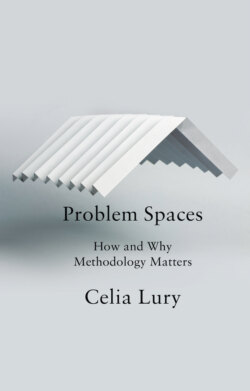Читать книгу Problem Spaces - Celia Lury - Страница 18
Thinking context
ОглавлениеA second important aspect of inquiry that both Dewey and Simon address is the role of cognition. In each case, the understanding of cognition put forward is not restricted to the thinking of an isolated human subject but is, rather, linked to the situated nature of a problem, or the (changing) relation of a (changing) problem to a (changing) context, system or environment.
Dewey argues that there is ‘nothing intellectual or cognitive’ in the existence of indeterminate situations: although they are the necessary condition of cognitive operations or inquiry ‘in themselves they are precognitive’. Despite this statement (which might seem to presume that cognition is only to be found in the human subject), the issue of how the distinction between cognitive and pre-cognitive is related to indeterminate situations is a little more complicated in pragmatist philosophy than it may first appear. As Rabinow remarks:
Neither the primary locus nor the yardstick of [the practice of inquiry] are to be found in the subject. Dewey makes this point through a striking, if ambiguous, formulation: “It is the needs of a situation which are determinative” (1916: 70). We can gloss his claim by saying that thinking is a temporally un-folding, situated practice, the function of which is to clarify and to realign a problematic situation. The site of the trouble and the resolution is the problematic situation. Intervention is judged successful when it yields a reconstructive change through meeting the needs of a situation. (Rabinow 2009: 16–17)
In this way of thinking, a context or environment is not necessarily without cognition itself: indeed, for some pragmatists, the activity of selection can be exercised by a context or environment. Charles Cooley, for example, proposes that in technological societies environments are increasingly organized by communication and information technologies, which extend the environment of a phenomenon across sites, conferring on environments a ‘one-among-many’ mode of existence. He notes that communications technology ‘permits [the social actor] to form his own environment by retaining what suits him from a variety of material’ (Cooley 1897; see Lury and Marres 2015). Indeed, he further says that the selection mechanisms that structure experience may be located beyond the individual and operate infrastructurally. On the one hand, ‘the man of today [is] less dependent on the environments that happen to be nearest him’; on the other, ‘a million environments solicit him’ (Cooley 1897: 23): in short, mechanisms of selections are equally operative within the environment. For a compositional methodology, the organization of relations between a problem and environment in the composition of a problem is not understood as the choice of researchers alone, but may also be informed by the environment. Mechanisms of selection demarcate an environment of experience and a situation, an ‘environmental occasion’ as it were, both with-in and out-with which a problem may be variously re-presented or transformed.
Writing after the rise of the computer, it seems obvious to Simon that cognition is not merely a solely human means of problem-solving, but is also a possible characteristic of the non-human. The limits of what he calls bounded rationality are not understood in terms of human cognition alone, but are the properties of a problem in changing and two-way (but not necessarily symmetrical) relations in complex cognitive environments.6 And such environments are not inert, or unchanging; indeed, they may be characterized by different kinds of distributed cognition.
For both Dewey and Simon, then, the relation of a problem to a context or environment not only changes in time but is cognitively distributed; for both, a notion of problematization that insists upon a stable, once-and-for-all distinction between a problem and a single environment is inadequate. This insight is acknowledged in Dewey’s use of the concept ‘pattern of inquiry’, since patterning typically involves a parallax effect of figure-ground, allowing the two-way relation between figure and ground, an object (or problem) and its environment(s), to be surfaced as part of an inquiry. Relatedly, the emphasis on the iterative relation between representation and intervention that follows from Simon’s use of the term of design leads him to emphasize the importance of the interactivity of interfaces to the artificial sciences. Indeed, for Simon, the interface is the primary epistemic tool of the artificial sciences:
An artifact can be thought of as a meeting point – an “interface” in today’s terms – between an “inner” environment, the substance and organization of the artifact itself, and an “outer” environment, the surroundings in which it operates. If the inner environment is appropriate to the outer environment, or vice versa, the artifact will serve its intended purpose. (1996: 6)
The value of the concept of interface for understanding the relation between science and society is the focus of discussion in Chapter 6.
